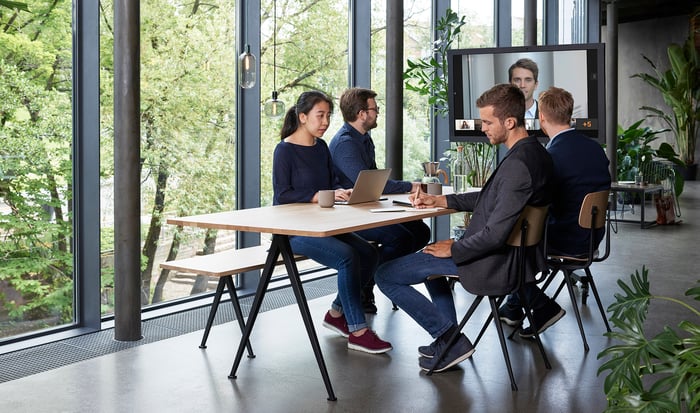You can think of a Virtual Meeting Room (VMR) as you would think of a physical one: Everyone knows where it is, it has a name, and holds some collaboration tools and likely a few chairs and a table you can sit around and discuss. It almost always contains a screen where you can share information, documents, presentations, and much more.
A Virtual Meeting Room is much the same. In this article, you can learn how global organizations hold virtual meetings in virtual conference rooms and meeting spaces using a VMR...
- What is a Virtual Meeting Room?
- How to use a VMR
- Virtual meetings and cultural change
- Video conferencing document sharing and presentations
- Video meeting capacity - VMRs
What is a Virtual Meeting Room?
Instead of having a physical location, a VMR has a virtual address in the form of a URI (Uniform Resource Identifier), formatted just like an email address. This address is unique. A VMR is a personal static resource, just like your email address. So perhaps, if your email address is name@company.com, your personal VMR would be meet.name@company.com.
But how do you use it and how can you benefit from having one?
How do I use a VMR?
A Pexip VMR is a simple and easy way to meet on video or audio, and in which you can share presentations and collaborate. It is always available and always accessible for ad-hoc or scheduled meetings. And, because it is a static resource with a unique name and address, it is easy to invite people to it.
You can access a VMR from nearly any type of device. A videoconferencing system, using a web browser, through Microsoft’s Lync, Skype or Skype for Business clients, a smartphone or a tablet, a regular phone, and in many other ways.
Once in a VMR – and unless you dial in by phone – you see the others in the room, as in a normal videoconference, or again, as in a standard meeting room. Speakers get attention, and take “the main stage”, i.e. occupy the largest part of the screen. A row of previous speakers and other attendees occupy the lower part of the screen as small thumbnail video pictures.
Attendees are chronologically ordered from left to right in the order they spoke or appeared in the meeting room, with the most recent to the left.
The cultural change – how people collaborate and how expectations change
How people cooperate and collaborate has changed dramatically over the past few years. The availability of tools, driven in a large part by consumer electronics such as smart phones and tablets, has changed how people consume information, where they can access it, and how. So too with visual collaboration and the way people work. Even children today find the use of visual meetings simple and easy through the use of Skype and FaceTime, and expect visual communications.
Work culture is driven by this. When do you want to meet and discuss? Now, when we have the idea, or later, when the collaboration meeting room is free? With a VMR, you can meet ad-hoc, when you have something to say, and not be constrained by meeting room and system availability.
How do I share documents or presentations?
A Pexip VMR supports presentation sharing from numerous devices. Of course, it is imperative that the device and software you join from supports sharing as well.
If you use Lync to join the VMR meeting, you can use Lync’s built in presentation and screen sharing to share a presentation that everybody else in the meeting will see. You can do the same from Skype for Business, from various dedicated video conferencing endpoints from the likes of Cisco, Sony, Polycom and many others, or you can do it from a web browser such as Google Chrome.
If you dial in audio-only via telephone, you can also watch shared content on your smartphone using the Pexip app – for instance when you are on the road, on a train, or in a location where Wi-Fi and video calling is not supported.
What is the capacity of a VMR – how many people can I have in the room?
For all practical purposes, a Pexip VMR can host any number of people and participants. The standard VMR meeting screen layout is that you see who’s speaking taking up the main part of the screen, and with a row of up to seven thumbnails across the bottom.
If the number of participants is greater than that, you will have an indicator saying so, in the form of “+X” participants. Pexip also has a layout that supports up to 21 little thumbnails, called a Virtual Auditorium™, for those larger meetings where participants are many.
Bottom line – you can use VMRs actively and to fit your way of working, and to drive decision processes when you want to
A Pexip Virtual Meeting Room is simply a meeting room in your pocket that you can invite meeting participants to. It’s your personal meeting room, and it supports participants from a near unlimited number of devices and endpoints. You can use it to share presentations, collaborate and meet.
Just like you would in a normal meeting room.
Now you've read the benefits of a Pexip VMR, you can experience our virtual conference room environment with a FREE demo.


.png?width=41&name=gillian%20(cropped).png)


